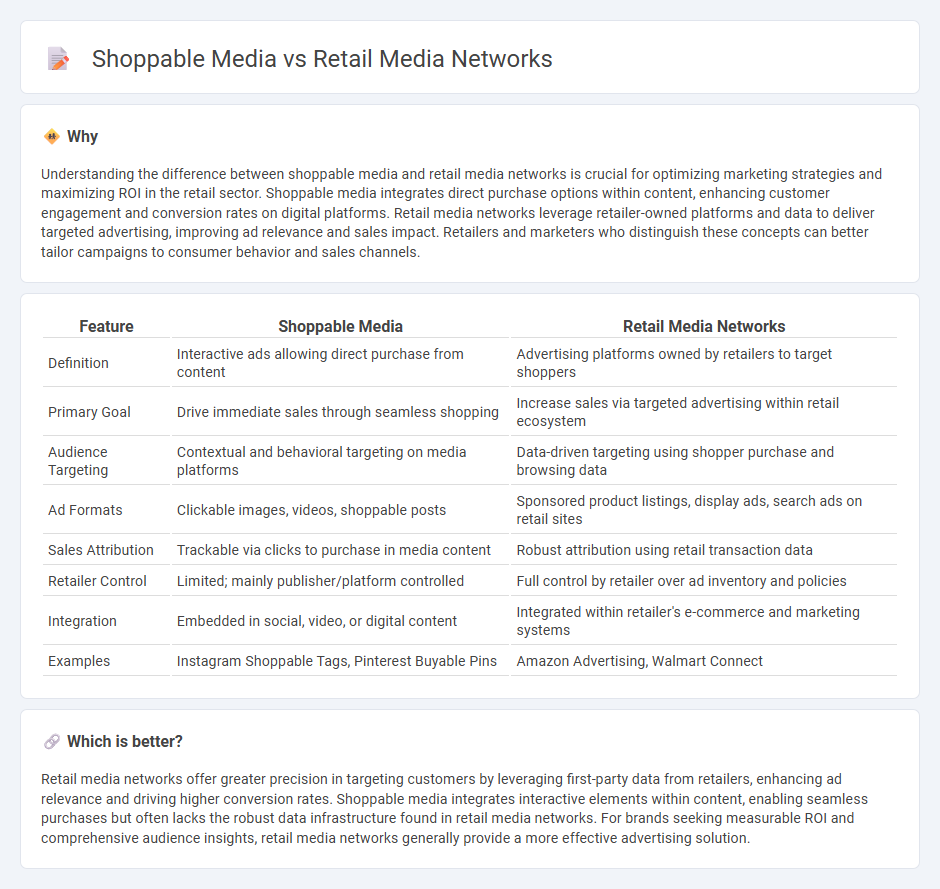
Shoppable media integrates interactive shopping features directly into content, allowing consumers to purchase products seamlessly without leaving the platform. Retail media networks leverage the retailer's digital properties to deliver targeted advertisements and promotions to shoppers based on real-time purchasing data. Explore how these innovative strategies transform consumer engagement and drive sales growth.
Why it is important
Understanding the difference between shoppable media and retail media networks is crucial for optimizing marketing strategies and maximizing ROI in the retail sector. Shoppable media integrates direct purchase options within content, enhancing customer engagement and conversion rates on digital platforms. Retail media networks leverage retailer-owned platforms and data to deliver targeted advertising, improving ad relevance and sales impact. Retailers and marketers who distinguish these concepts can better tailor campaigns to consumer behavior and sales channels.
Comparison Table
| Feature | Shoppable Media | Retail Media Networks |
|---|---|---|
| Definition | Interactive ads allowing direct purchase from content | Advertising platforms owned by retailers to target shoppers |
| Primary Goal | Drive immediate sales through seamless shopping | Increase sales via targeted advertising within retail ecosystem |
| Audience Targeting | Contextual and behavioral targeting on media platforms | Data-driven targeting using shopper purchase and browsing data |
| Ad Formats | Clickable images, videos, shoppable posts | Sponsored product listings, display ads, search ads on retail sites |
| Sales Attribution | Trackable via clicks to purchase in media content | Robust attribution using retail transaction data |
| Retailer Control | Limited; mainly publisher/platform controlled | Full control by retailer over ad inventory and policies |
| Integration | Embedded in social, video, or digital content | Integrated within retailer's e-commerce and marketing systems |
| Examples | Instagram Shoppable Tags, Pinterest Buyable Pins | Amazon Advertising, Walmart Connect |
Which is better?
Retail media networks offer greater precision in targeting customers by leveraging first-party data from retailers, enhancing ad relevance and driving higher conversion rates. Shoppable media integrates interactive elements within content, enabling seamless purchases but often lacks the robust data infrastructure found in retail media networks. For brands seeking measurable ROI and comprehensive audience insights, retail media networks generally provide a more effective advertising solution.
Connection
Shoppable media integrates interactive advertising with seamless purchasing options, directly linking consumers to products within digital content. Retail media networks leverage this by creating targeted ad placements on retailer-owned platforms, boosting conversion rates through personalized shopping experiences. Together, they enhance omnichannel strategies, driving higher engagement and measurable sales growth for brands and retailers alike.
Key Terms
Advertising Inventory
Retail media networks leverage advertising inventory within e-commerce platforms, enabling brands to place targeted ads on retail websites, apps, and search results to directly influence purchase decisions. Shoppable media, by contrast, integrates interactive elements within content like videos or social posts, allowing consumers to click and shop seamlessly without leaving the media environment, thereby offering a more immersive shopping experience. Explore how these advertising inventory strategies can enhance customer engagement and drive sales growth.
Purchase Path Integration
Retail media networks integrate advertising directly within retailer platforms, enabling targeted promotions at key points in the purchase path to drive conversions. Shoppable media embeds product purchasing options within content, streamlining the buying process by reducing friction from discovery to transaction. Explore how these strategies enhance consumer engagement and sales efficiency in modern digital commerce.
First-Party Data
Retail media networks leverage first-party data collected directly from consumer transactions and loyalty programs to deliver personalized ad experiences on retailer platforms, enhancing targeting accuracy and ROI. Shoppable media integrates first-party data within content to create seamless purchase opportunities, turning engagement into immediate sales through interactive ads and embedded links. Explore how first-party data drives the effectiveness of both retail media networks and shoppable media for optimized marketing strategies.
Source and External Links
What are Retail Media Networks? - Retail media networks (RMNs) are platforms that enable retailers to monetize their first-party shopper data by offering advertising opportunities on their digital and physical channels, with major players including Amazon Ads, Walmart Connect, Target Roundel, and Kroger Precision Marketing.
Retail Media Networks: What They Are, Who is Launching ... - RMNs are retailer-owned ad platforms using first-party shopper data across digital assets such as websites, apps, stores, and partner channels, providing advertisers proximity to the point of sale and new revenue streams for retailers.
What are retail media networks? - Retail media networks are advertising platforms where brands can run campaigns on retailers' websites, apps, and physical locations combining personalized targeting via first-party data, with Amazon and Walmart as leading examples in market share.
 dowidth.com
dowidth.com